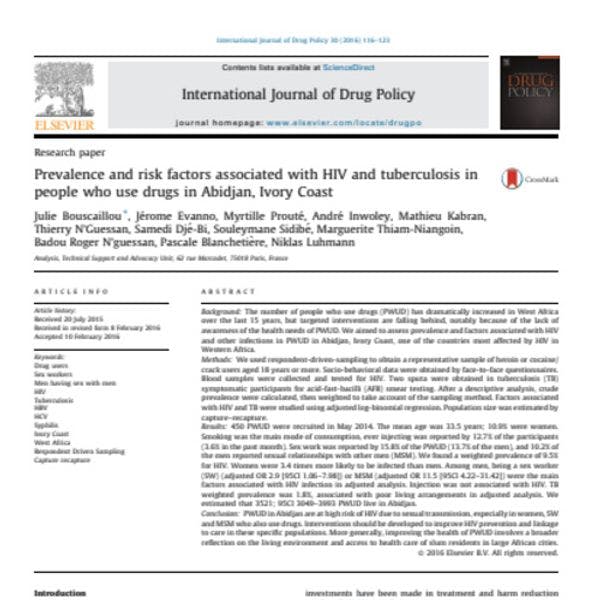Prevalence and risk factors associated with HIV and tuberculosis in people who use drugs in Abidjan, Ivory Coast
In West Africa, institutional weakness due to decades of political conflict has led to a worrying growth of cocaine and other drug trafficking. Local consumption has also dramatically increased, though the real extent of illicit drug use remains unknown. While efforts to address the problem have mostly focused on arrests of users and petty drug dealers, very few investments have been made in treatment and harm reduction services (WACD, 2014).
Yet drug use poses significant public health risks. Globally, injecting drug users (IDU) are disproportionately infected with HIV, with incidence estimated to be up to 22 times greater than in the general population (Mathers et al., 2008). Increased HIV prevalence is also reported in non-injecting drug users (NIDU), especially because of increased sexual risk behaviors, and overlapping social and sexual networks with IDU (Strathdee & Stockman, 2010). The small amount of data available in West Africa reports higher HIV rates in People who use drugs (PWUD) than in the general population (5.2% in Senegal, and between 3% and 9.3% in Nigeria) (Eluwa, Strathdee, Adebayo, Ahonsi, & Adebajo, 2013; Lepreˆtre et al., 2015). PWUD also remain disproportionately affected by viral hepatitis B and C (HBV, HCV), and syphilis (Coffin et al., 2010; Nelson et al., 2011). In addition, drug use is associated with a number of factors that together contribute to higher risks of tuberculosis (TB), including direct detrimental effect on the immune system, use of tobacco, homelessness, or repeated incarcerations (Deiss, Rodwell, & Garfein, 2009).
With a HIV prevalence of 3.7% in the general population, Ivory Coast is one of the most affected countries of West Africa (DHS, 2013). Abidjan, the main city, shows even higher rates, with an HIV prevalence estimated at 5.1% (DHS, 2013). The smoking of heroin ‘‘Pao’’ and crack cocaine ‘‘Yo’’ is very common in Abidjan, taking place most of the time in ‘‘fumoirs’’, which are insalubrious and crowded spaces dispersed within urban slums. Heroin is mainly used in a rolled cigarette of cannabis, whereas crack cocaine is smoked using handmade pipes ‘‘Zeb’’. Other, less frequent, consumption patterns are observed, such as chasing the dragon, snorting cocaine, or oral consumption of psychotropic pharmaceutical drugs (amphetamine pills known as ‘‘Bleu bleu’’, clonazepam ‘‘Rivo’’, barbiturate ‘‘sekou toure´’’ and different ephedrine combinations). Injecting drug use exists, but is uncommon and deprecated by Ivorian PWUD.
Ivorian authorities are determined to develop a public health approach adapted to populations at high risk of HIV. They already work closely with sex workers (SW) and men having sex with men (MSM), who face alarmingly high HIV prevalence rates: 26.6% in female SW (Vuylsteke et al., 2012a) and 50% in male SW (Vuylsteke et al., 2012b), and 18% in MSM (Hakim et al., 2015). However, PWUD’s health needs are barely known, and very few health organizations are currently working with this population. Our study aimed to collect reliable data on HIV, TB, viral hepatitis, and syphilis among highly vulnerable PWUD in Abidjan.
Keep up-to-date with drug policy developments by subscribing to the IDPC Monthly Alert.
Downloads
Topics
Regions
Related Profiles
- International Journal of Drug Policy
